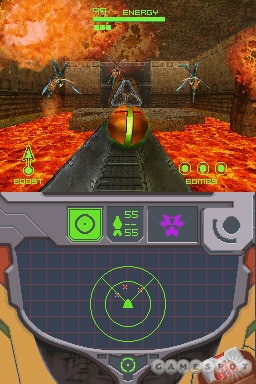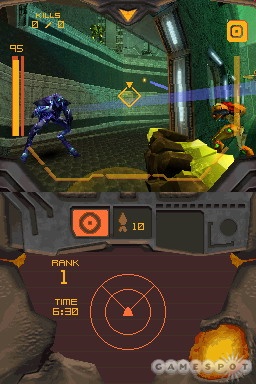Given how long the Nintendo DS has been available, it's hard to believe that Metroid Prime: Hunters was one of the first games shown off when the system was first introduced. Some of you early adopters may remember getting a brief demo level of the first-person shooter as a pack-in with your system. After a long wait, the game is finally out, and for the large part, it hits the nail on the head as far as delivering a faithful Metroid Prime experience in the handheld. It's also got the best multiplayer options we've seen yet in a Metroid game and surprisingly fluid controls.

In Hunters, you reprise the role of Samus Aran, everyone's favorite bounty-hunting heroine. You'll search a small batch of planets in an area known as the Alimbic Cluster for a cryptic "ultimate power" that's said to be hidden in the system. The key to this power involves finding and unearthing eight different artifacts called octoliths. Why not three? Because then it'd be called the tri-force or something. These octoliths are scattered across a few different planets and space stations. Samus isn't the only one searching out these octoliths, though. You'll come across several other bounty hunters with unique weapons and abilities that will duel you during your trip and attempt to steal your hard-earned octoliths. Lose a battle with one, and they'll steal them--beat the same bounty hunter later, and you'll recover your lost octoliths.
Controlling Samus is one of Hunters' strong points, at least once you get used to the controls. The default scheme has you dragging your stylus on the bottom screen to aim your weapons, while you use the D pad to move forward and backward or strafe left and right. Left-handed input methods also exist, so southpaws needn't fret over the prospect of using their right hand to aim with the stylus. The shoulder button lets you fire your selected weapon, while double tapping the touch screen will let you jump. Unlike the Metroid Prime games on the GameCube, there is no lock-on. You have to do all your own aiming. The stylus method can be a little awkward to learn for some, and it induced cramps in our hands at first; the temptation exists to switch the controls to the more familiar D pad and face buttons for your movement and aiming scheme. But if you stick with the stylus control, you'll find that you have much more precision over your aiming, and you're able to execute circle-strafes and other FPS-style maneuvers with ease. Up the sensitivity and you'll even be able to spin 180s, which can be key in multiplayer. In many ways, Hunters' unique control gives it a precise and speedy feel much closer to the keyboard-and-mouse input of PC shooters than you can get from typical dual-analog stick control schemes on console shooters.

The downside to the interface is that to switch weapons, change into morphball mode, or access your scan visor, there are small touch panels on the touch screen that you need to tap. It's possible to accidentally drag your stylus over these areas and unexpectedly swap to missiles, for example. It's also less than ideal to take your eyes off the main screen to find exactly where you need to press to swap weapons in the midst of battle. These compromises are not all that burdensome though, and the tradeoff for speedy, precision aiming is definitely worthwhile.
Hunters' single-player adventure mode has you exploring several different planet types that run the gamut of typical Metroid settings. You've got your abandoned tech station, an ice world, ancient ruins, and a lava world, among others. The art style of the levels is definitely evocative of previous Metroid Prime games, and the game engine does a pretty good job of rendering rooms. When the action gets hot and heavy, the frame rate can dip noticeably, but it's pretty rare when it happens. The detail put into the boss and bounty-hunter models is great, and everything animates nicely. There are a generous number of cutscenes that sometimes stretch across both screens or use separate camera angles in each screen for cinematic effect. Our only major gripe with the graphics is that they can look grainy at times, particularly when you're engaging in a long-range shooting battle with...something that you can't quite make out. The resolution limitations of the DS may be more to blame for this problem than the game engine, though. On the plus side, Hunters sounds fantastic, both from an effects and a music standpoint. Hunters offers some familiar tunes, which contribute to the authentic Metroid feel and experience, while the weapon sounds and explosions offer great feedback in both single-player and multiplayer.
As you make your way through the campaign, you'll not only find the storied octoliths, but also uncover the lore behind the ultimate power (you are using your scan visor, right?) and unlock a number of different beam weapons, ranging from an ice beam that bounces off walls to a fire gun that does added burn damage on impact to a sniping laser. In typical Metroid fashion, you'll have to backtrack to earlier areas with your new guns to open up doors that were previously inaccessible to you, though you don't have to find and unlock all your abilities--the morphball mode and bombs are available to you at the outset.

There are some disappointing aspects to the campaign, though. For one thing, the level design feels more linear and uninspired than in any other Metroid game. Sure there are simple puzzles to solve, maybe a couple branching pathways here and there, and some morphball mazes, but the unified, organic level design that typifies the Metroid franchise is missing. Instead, Hunters offers a cookie-cutter feel to its planets, with sometimes repetitive room architecture. You'll make your way down a mostly obvious path, picking up energy tank and missile upgrades or maybe a new gun. You'll then take out a bounty hunter and a boss (many of which are recycled), grab your octolith, and leave. After picking up an octolith, you'll have to quickly evacuate to your ship as a countdown timer ticks down--this makes no logical sense, though, as nothing happens when you reach your ship. There's no dramatic escape from an exploding planet (you do have to come back later, after all) and nothing that suggests what the urgency to leave was in the first place.
The multiplayer aspect to Metroid Prime: Hunters holds, perhaps surprisingly for a Metroid game, more appeal than its single-player game. You can play with up to four players locally through game sharing or multicard and online for up to four players through Nintendo's Wi-Fi service. Single-card game sharing limits you to playing standard battle (deathmatch) mode, and all players have to play as Samus. However, multicard battles and online play let you use any of the bounty hunters you've defeated in the single-player campaign. Each hunter has a unique alt form (such as Samus' morphball) and special weapon. Weavel, for example, can split himself into two, with his bottom half being an automated turret, while his top half can run around and melee or find more power-ups. Each character has different strengths that can be exploited depending on the arena, though not all can be used with each game mode.
For multicard play, a number of different other game types are available, including one- and two-flag variants of capture the flag (or the octolith, in this case), last man standing, king of the hill, and "prime hunter." The latter is a variation of assassin where one player has the prime hunter designation and must hold it for as much time as possible while others attempt to kill that player and take the title. Team play versions are available for the appropriate game types. The game host has the ability to set options for point limits, time limits, and even restrict the use of radar and other options. You can insert bots of varying skill levels to play against to fill out the rest of the field, so you don't necessarily need three friends with the game to enjoy these multiplayer modes. The bots offer a respectable challenge at the higher difficulty levels and are worthwhile to play against if you can't scrounge up some buddies. To help you on that front, a rivals radar is included, which is similar to Nintendogs' bark mode--set this option on, put your DS on sleep, and any other Hunters owners you pass by who have their rivals radar on will be added to your rivals list. Presumably this allows you to build up a nice list of opponents for online play, but its utility is questionable for anyone outside a large concentration of other DS owners, like in a school perhaps.

Online play for four players is also available. Searching for a game is as simple as logging in, and Nintendo's Wi-Fi service will automatically match you up with three other players. Once you're logged in, each player has a few seconds to select their preferred hunter before the game automatically loads up a voting screen for players to vote on the map to play. The online action was smooth and lag free in our experience, and you're likely to find stiff challenges online against other human opponents. The game ranks you based on how many kills you get and matches you play and keeps track of other stats, such as your favorite weapon, how many kills you get in bipedal or alt mode, and others. The strategies are pretty young at this point, but a popular one so far seems to be using a hunter with a melee-attacking alt form to charge in and spam close-range attacks.
Online play is overall quite fun, but it has its quirks. For one thing, the only mode you can just play online right from the get-go is battle mode. The only way to access the other online modes is by playing against those on your friends and rivals list. So while it's all well and good that you do have access to all the multiplayer modes online, the fact that you have to input lengthy friend codes in order to access all of the game modes is annoying. Once you do that, you can see who's online and host a game or join an existing game that's open to you. You can even send voice messages to each other while in the lobby of a friend's (but not a rival's) game, or send text-based messages that you can type in using a keyboard that appears on the touchscreen. Both communication options work pretty well, but once the game starts, you can't message each other anymore, so the trash talking ends.
Despite those caveats, Metroid Prime: Hunters is an excellent multiplayer game and easy to recommend to anyone who enjoys FPS action. The single-player is also well worth a play through, despite its limitations, if only to take in the story and unlock all the hunters for multiplayer action.
Editor's note 03/23/06: Our review originally overlooked specific aspects of the friends/rivals system, which required a reevaluation of these parts of the game and a revision to the text. GameSpot regrets the errors.